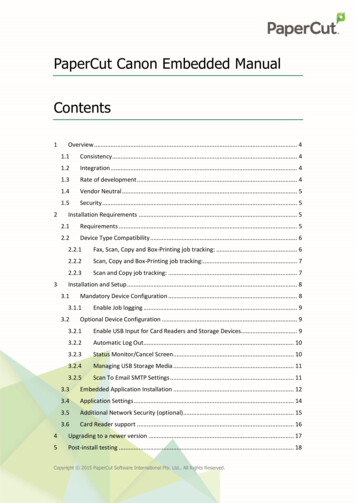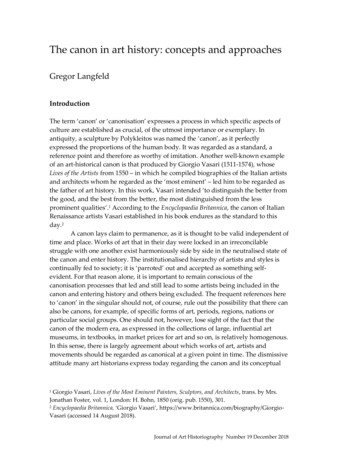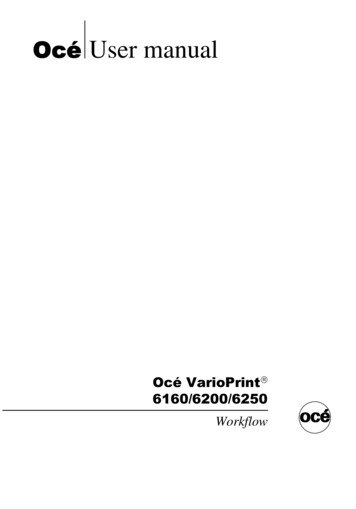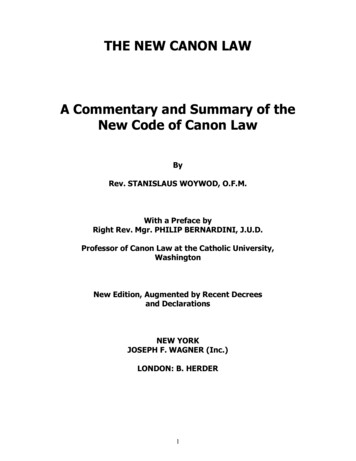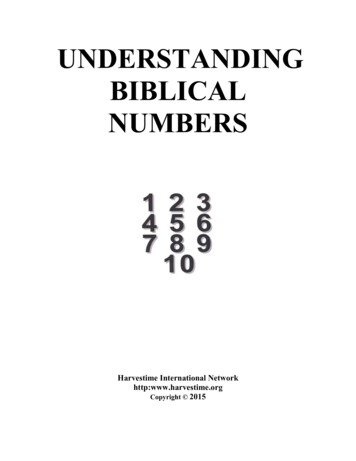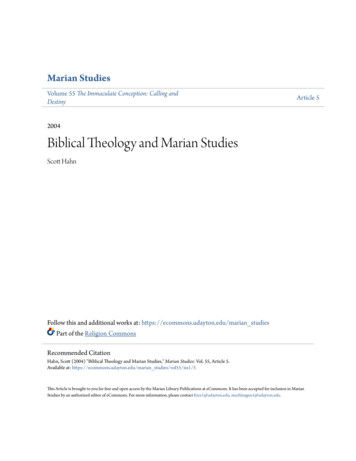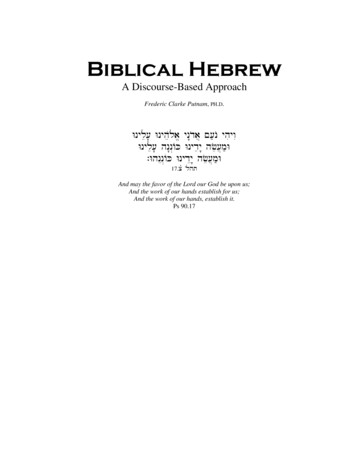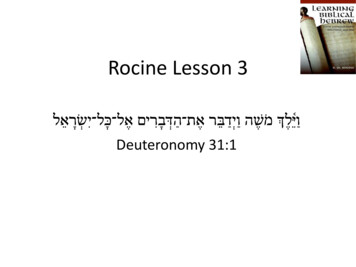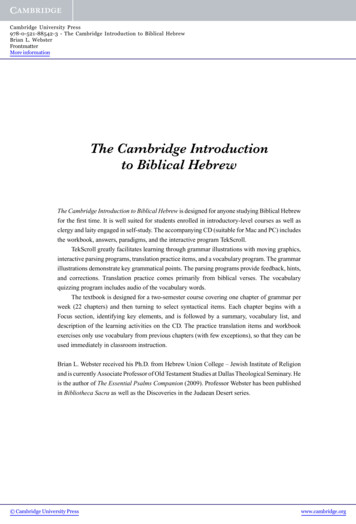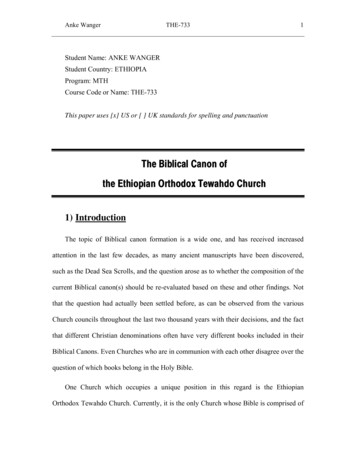
Transcription
Anke WangerTHE-7331Student Name: ANKE WANGERStudent Country: ETHIOPIAProgram: MTHCourse Code or Name: THE-733This paper uses [x] US or [ ] UK standards for spelling and punctuationThe Biblical Canon ofthe Ethiopian Orthodox Tewahdo Church1) IntroductionThe topic of Biblical canon formation is a wide one, and has received increasedattention in the last few decades, as many ancient manuscripts have been discovered,such as the Dead Sea Scrolls, and the question arose as to whether the composition of thecurrent Biblical canon(s) should be re-evaluated based on these and other findings. Notthat the question had actually been settled before, as can be observed from the variousChurch councils throughout the last two thousand years with their decisions, and the factthat different Christian denominations often have very different books included in theirBiblical Canons. Even Churches who are in communion with each other disagree over thequestion of which books belong in the Holy Bible.One Church which occupies a unique position in this regard is the EthiopianOrthodox Tewahdo Church. Currently, it is the only Church whose Bible is comprised of
Anke WangerTHE-733281 Books in total, 46 in the Old Testament, and 35 in the New Testament.1 It is also thebiggest Bible, according to the number of books: Protestant Bibles usually contain 66books, Roman Catholic Bibles 73, and Eastern Orthodox Bibles have around 76 books,sometimes more, sometimes less, depending on their belonging to the Greek Orthodox,Slavonic Orthodox, or Georgian Orthodox Church.2And although the Ethiopian Orthodox Church belongs to the group of OrientalOrthodox Churches which are in communion with each other, there is no commonconsensus among them as to which books make up the Biblical canon; for example, theCoptic Orthodox Church has the same canon as Western Protestant Churches, with theaddition of the two Epistles of Clement in the New Testament (a total of 68 books).3This paper will present the Biblical canon of the Ethiopian Orthodox TewahdoChurch, and the various canons produced by synods and Church Fathers which haveinfluenced the collection of Biblical books in this particular Church.2) The Bible in the Ethiopian Orthodox Tewahdo ChurchAs mentioned above, the Bible of the Ethiopian Orthodox Church consists of 81books, 46 in the Old Testament, and 35 in the new.4 With this, the Ethiopian Orthodox1Cherenet Abebe. Meseretawi yemetsehaf kidus atenan zede. (Foundational Bible Study). Addis Abeba,2011. p.91-92, 162-1632Wikipedia, Biblical canon. Available from: http://en.wikipedia.org/wiki/Biblical canon (accessedNovember 26, 2011)3Wikipedia, Development of the New Testament canon. Available from:http://en.wikipedia.org/wiki/Development of the New Testament canon (accessed November 26, 2011)4Cherenet Abebe. Meseretawi yemetsehaf kidus atenan zede. (Foundational Bible Study).p.91-92, 162-163
Anke WangerTHE-7333Church has the most extensive collection of Biblical books considered to be canonical ofall the major Christian denominations.5 The number of books as well as the exact titlesare laid down in the Feteha Negest (Law of the Kings), a book of law used in ChristianEthiopia since at least the 16th century, based on an Arabic manuscript written by aChristian Egyptian in 1238, which lists the books of the Bible. In Section 2, it states thenumber is to be 81; the actual titles of the books are mentioned in the text as well as in“Reading and Explanation of the Feteha Negest” (a kind of commentary).It should not come as a surprise that most of the “additional” books (those notaccepted by all or most other Churches) are books that either have been consideredcanonical Scripture by one or more of the other Churches at some point, and/or aresummarized as Apocrypha or Pseudepigrapha by them today, meaning that theyconstitute the books about which there always has been a certain amount of discussion asto whether they actually should be considered as canonical or not. However, some of thebooks that we find in the Ethiopian Biblical canon do not fulfill these criteria, either, butare completely unique to that particular Church.6 7Yet another curious thing is that, although the number of books in the EthiopianOrthodox Bible is always 81, this number is most commonly reached in two differentways (although other ways did and do exist).85Wikipedia, Biblical canon (accessed November 26, 2011)6Wikipedia, Biblical canon (accessed November 26, 2011)7R. W. Cowley, The Biblical Canon Of The Ethiopian Orthodox Church Today, in: Ostkirchliche Studien,1974, Volume 23, pp. 318-323.8R. W. Cowley, The Biblical Canon Of The Ethiopian Orthodox Church Today, p. 318-323.
Anke WangerTHE-7334Furthermore, there is currently no distinction at all between the book that are referredto as protocanoncial and deuterocanonical. Whereas the Ethiopian Orthodox Churchunderstand and uses these terms when referring to the respective books in, for example,the Catholic or Eastern Orthodox Church, or in the ancient writing, like the Festal Letterof St. Athanasius (see below), it does not differentiate in its own Bible between protoand deuterocanon. All books accepted into the Bible are considered equally inspired,equally the Word of God, and equally instructive (albeit for different situations andcircumstances.9a) Books of the Old TestamentIn the official rendering, the number of the Old Testament books in the EthiopianOrthodox Church is 46, divided into four sections. Those books include10 11: Books of Law (the 5 Books of Moses):o Genesiso Exoduso Leviticuso Numberso Deuteronomy Books of History9Cherenet Abebe. Meseretawi yemetsehaf kidus atenan zede. (Foundational Bible Study). Addis Abeba,2011. p.47-6110Ethiopian Orthodox Tewahdo Church. The Ethiopian Orthodox Tewahdo Church: Faith, Order ofWorship and Ecumenical Relations, Addis Abeba, 1996. p.45-4711Cherenet Abebe. Meseretawi yemetsehaf kidus atenan zede. (Foundational Bible Study). p.91f.
Anke WangerTHE-7335o Joshuao Judgeso Rutho 1st and 2nd Samuelo 1st and 2nd Kingso 1st and 2nd Chronicles (2nd Chronicles includes the Prayer ofManasseh)o Ezra and Nehemiaho Ezra Sutuel and 2nd Ezrao Tobito Juditho Esthero 1st Meqabeyano 2nd and 3rd Meqabeyano Joseph Ben Guriyono Jubileeso Enoch Books of Psalms (Songs) and Wisdomo Jobo Psalmso Proverbso Reproof (“Tsegats” in Ge’ez)o Ecclesiastes
Anke WangerTHE-7336o Song of Songso Wisdom (of Solomon)o Sirach Books of Prophecyo Isaiaho Jeremiah (including Lamentations, the Remainder of Jeremiah, andBaruch)o Ezekielo Daniel (including Susannah, the Prayer of the Three Children, and Beland the Dragon)o Hoseao Amoso Micaho Joelo Obadiaho Jonaho Nahumo Habakkuko Zephaniaho Haggaio Zechariaho Malachi
Anke WangerTHE-7337It should be noted that the three books of “Meqabeyan” are not identical with thebooks of “Macabees”, although there is a certain overlap regarding content.As mentioned above, this is the official rendering. In the actual Bible which iscurrently on the market, the arrangement is somewhat different: 1st and 2nd Samuelhave been printed as individual books in it, similarly 1st and 2nd Kings, 1st and 2ndChronicles, and 2nd and 3rd Meqabeyan. Also, Ezra and Nehemiah have beenseparated, as have Ezra Sutuel and 2nd Ezra. All the writings of Jeremiah, which areone book in the official rendering, have been separated in the actual printing:Jeremiah, Baruch, Lamentations, and the Remainder of Jeremiah; there is also a booktitled “the Remainder of Baruch”. The book of Joseph Ben Guriyon has beeneliminated. In the actual print version, therefore, the number of Old Testament booksis 54. The order also varies; in the print version it is: Genesis, Exodus, Leviticus,Numbers, Deuteronomy, Joshua, Judges, Ruth, 1st and 2nd Samuel, 1st and 2nd Kings,1st and 2nd Chronicles, Jubilees, Enoch, Ezra, Nehemiah, Ezra Sutuel, 2nd Ezra, Tobit,Judith, Esther, 1st Meqabeyan, 2nd Meqabeyan, 3rd Meqabeyan, Job, Psalms,Proverbs, Reproof, Wisdom, Ecclesiastes, Song of Songs, Sirach, Isaiah, Jeremiah,Baruch, Lamentations, Remainder of Jeremiah, Remainder of Baruch, Ezekiel,Daniel, Hosea, Amos, Micah, Joel, Obadiah, Jonah, Nahum, Habakkuk, Zephaniah,Haggai, Zechariah, and Malachi.1212Ethiopian Bible Society. Metsehaf Kidus (The Holy Bible, Amharic version). Addis Abeba, 2007.
Anke WangerTHE-7338b) Books of the New TestamentAs for the New Testament, the Ethiopian Orthodox Church receives the followingbooks into its canon (in that order)13 14: Gospels:o Gospel of Matthewo Gospel of Marko Gospel of Lukeo Gospel of John History:o Acts (of the Apostles) Epistles of Paul:o Romanso 1st Corinthianso 2nd Corinthianso Galatianso Ephesianso Philippianso Colossianso 1st Thessalonians13Ethiopian Orthodox Tewahdo Church. The Ethiopian Orthodox Tewahdo Church: Faith, Order ofWorship and Ecumenical Relations. p.45-4714Cherenet Abebe. Meseretawi yemetsehaf kidus atenan zede. (Foundational Bible Study). p.162f.
Anke WangerTHE-7339o 2nd Thessalonianso 1st Timothyo 2nd Timothyo Titoo Philemono Hebrews Other Epistleso 1st Petero 2nd Petero 1st Johno 2nd Johno 3rd Johno James (called “Yaqob” in Ge’ez)o Jude Prophecyo Revelation of John Books of Church Order (based on the “Apostolic Constitutions” and theEpistles of Clement)o The Order of Ziono Commandments (Te’ezaz)o Abtilso “Gitzew”o 1st Book of Covenant
Anke WangerTHE-73310o 2nd Book of Covenanto Clemento DidascaliaExcept for the books of Church Order, the canon agrees mostly with that received byother Churches. As we see, in this official rendering, the number of books is 35,making a total of 81 with the 46 books of the Old Testament. In the actual printing,however, the 8 books of Church Order are not printed (as they are generally notwidely available), so that in the printed version, the number of New Testament booksis 27, making again a total of 81 with the actual 54 books of the Old Testament.How the Ethiopian Orthodox Tewahdo Church came to accept those 81 books, andwhich ancient canons played in a role in that decision will be the topic of the nextfew sections.3) Canons influencing the Biblical Canon of the EthiopianOrthodox Tewahdo ChurchThere are two types of canons that mainly influenced the discussion in the EthiopianOrthodox Church as to which Books of the Bible should be considered canonical. Thoseare canons issued by the various synods and councils, for one, and canons proposed byEarly Church Fathers in their writings.15 (Canons available in Ge’ez tend to be15Dibekulu Zewde. 81 Kidusat Metsaheftena Minchoch-Kenonat (The 81 Holy Books and the Sources –Canons). Addis Abeba, 1995. p. 35-61
Anke WangerTHE-73311translations and/or compilations of these, not actually canons written by local Churchscholars.)a) Synodical canonsAs for the canons issued by synods and councils, there are three which areconsidered to have a had a major influence on the Ethiopian Church, not only in regard toBiblical books, but also regarding Church Law in general: the 85 Apostolic Canons, theSynod of Laodicea, and the Synod(s) of Carthage.16i) The 85 Apostolic CanonsThe Apostolic Canons are defined by the Encyclopedia Britannica as:[A] collection of eighty-five rules for the regulation of clerical life, appended to theeighth book of the Apostolical Constitutions (q.v.). They are couched in brief legislativeform though on no definite plan, and deal with the vexed questions of ecclesiasticaldiscipline as they were raised towards the end of the 4th century . At least half of thecanons are derived from earlier constitutions, and probably not many of them are the actualproductions of the compiler, whose aim was to gloss over the real nature of theConstitutions, and secure their incorporation with the Epistles of Clement in the NewTestament of his day . The Codex Alexandrinus does indeed append the ClementineEpistles to its text of the New Testament . The Canons may be a little later in date than16Dibekulu Zewde. 81 Kidusat Metsaheftena Minchoch-Kenonat (The 81 Holy Books and the Sources –Canons). p. 35-48
Anke WangerTHE-73312the preceding Constitutions, but they are evidently from the same Syrian theologicalcircle.17Note that it states here that one of the goals of these canons was to have theApostolic Constitutions and the Epistles of Clement included in the New Testament. Thiswas at least partially successful in the Ethiopian Church, which does include the eightBooks of the Constitutions (with the Epistles of Clement worked into them), and in itssister Church, the Coptic Church, which still lists the two Epistles of Clement ascanonical in its New Testament.Another encyclopedia defines the Apostolic Canons a little more neutrally:The Apostolic Canons or Ecclesiastical Canons of the Same Holy Apostles[2] is acollection of ancient ecclesiastical decrees concerning the government and discipline of theEarly Christian Church, first found as last chapter of the eighth book of the ApostolicConstitutions and belonging to genre of the Church Orders.These eighty-five canons were approved by the Eastern Council in Trullo in 692 butrejected by Pope Constantine. In the Western Church only fifty of these canons circulated,translated in Latin by Dionysius Exiguus in about 500 AD, and included in the Westerncollections and afterwards in the "Corpus Juris Canonici". Canon n. 85 contains a list ofcanonical books, thus it is important for the history of the Biblical canon.18The work in which they are found, the Apostolic Constitutions (also called theConstitutions of the Holy Apostles), “contains eight treatises on Early Christian1718Apostolic Canons. In: Encyclopedia Britannica, Volume V02, p. 201. Cambridge University Press, 1911Wikipedia, Canons of the Apostles. Available from:http://en.wikipedia.org/wiki/Canons of the Apostles (accessed November 25, 2011)
Anke WangerTHE-73313discipline, worship, and doctrine, intended to serve as a manual of guidance for theclergy, and to some extent for the laity. It purports to be the work of the Twelve Apostles,whose instructions, whether given by them as individuals or as a body.” 19The article continues to state:The Church seems never to have regarded this work as of undoubted Apostolicauthority. [ ]. The Quinisext Council in 692 rejected most part of the work on account ofthe interpolations of heretics. Only that portion of it to which has been given the nameCanons of the Apostles was received in the Eastern Christianity. Even if not regarded as ofcertain Apostolic origin, however, in antiquity the Apostolic Constitutions were heldgenerally in high esteem and served as the basis for much ecclesiastical legislation. TheApostolic Constitutions were accepted as canonical by John of Damascus and, in a modifiedform, included in the 81 book canon of the Ethiopian Orthodox Church.20The already mentioned 85th, the last, canon, lists the Books of the Holy Bible thatshould be considered canonical:Let the following books be esteemed venerable and holy by you, both of the clergy andlaity. Of the Old Covenant: the five books of Moses—Genesis, Exodus, Leviticus, Numbers,and Deuteronomy; one of Joshua the son of Nun, one of the Judges, one of Ruth, four of theKings, two of the Chronicles, two of Ezra, one of Esther, one of Judith, three of theMacabees, one of Job, one hundred and fifty psalms; three books of Solomon—Proverbs,Ecclesiastes, and the Song of Songs; sixteen prophets. And besides these, take care thatyour young persons learn the Wisdom of the very learned Sirach. But our sacred books,19Wikipedia, Apostolic Constitutions. Available from:http://en.wikipedia.org/wiki/Apostolic Constitutions (accessed November 25, 2011)20Wikipedia, Apostolic Constitutions (accessed November 25, 2011)
Anke WangerTHE-73314that is, those of the New Covenant, are these: the four Gospels of Matthew, Mark, Luke,and John; the fourteen Epistles of Paul; two Epistles of Peter, three of John, one of James,one of Jude; two Epistles of Clement; and the Constitutions dedicated to you the bishops byme Clement, in eight books; which it is not fit to publish before all, because of the mysteriescontained in them; and the Acts of us the Apostles.21A comparison between this and the other canons, and the list of canonical Books inthe Ethiopian Orthodox Church, will follow in a later section.ii) The Synod of LaodiceaAnother council which is considered influential in determining the Ethiopian BiblicalCanon is the Synod of Laodicea. This was a regional synod of approximately thirtyclerics from Asia Minor that assembled about 363–364 AD in Laodicea in Phrygia.The major concerns of the Council involved regulating the conduct of churchmembers. The Council expressed its decrees in the form of written rules or canons. Amongthe sixty canons decreed, several aimed at: Maintaining order among bishops, clerics and laypeople (canons 3–5, 11–13, 21–27, 40–44, 56–57) Enforcing modest behavior of clerics and laypeople (4, 27, 30, 36, 53–55) Regulating approach to heretics (canons 6–10, 31–34, 37), Jews (canons 16, 37–38) andpagans (canon 39)21Philip Schaff, Ante-Nicene Fathers (ANF) Vol. 07, Constitutions of the Holy Apostles. Christian ClassicsEthereal Library, Grand Rapids, MI, 2004. p. 759
Anke Wanger THE-73315Outlawing the keeping of the Jewish Sabbath (Saturday) and encouraging rest on theLord's Day (Sunday) (canon 29) Outlining liturgical practices (canons 14–20, 21–23, 25, 28, 58–59) Restrictions during Lent (canons 45, 49–52) Admission and instruction of catechumens and neophytes (canons 45–48) Specifying a Biblical canon (canons 59–60).22In regard to the determination of the Biblical Canon in the Church, the canons ofinterest are of course canons 59 and 60, which read as follows:Canon LIX.NO psalms composed by private individuals nor any uncanonical books may be read inthe church, but only the Canonical Books of the Old and New Testaments.Canon LX.THESE are all the books of Old Testament appointed to be read: 1, Genesis of theworld; 2, The Exodus from Egypt; 3, Leviticus; 4, Numbers; 5, Deuteronomy; 6, Joshua, theson of Nun; 7, Judges, Ruth; 8, Esther; 9, Of the Kings, First and Second; 10, Of the Kings,Third and Fourth; 11, Chronicles, First and Second; 12, Esdras, First and Second; 13, TheBook of Psalms; 14, The Proverbs of Solomon; 15, Ecclesiastes; 16, The Song of Songs; 17,Job; 18, The Twelve Prophets; 19, Isaiah; 20, Jeremiah, and Baruch, the Lamentations, andthe Epistle; 21, Ezekiel; 22, Daniel.And these are the books of the New Testament: Four Gospels, according to Matthew,Mark, Luke and John; The Acts of the Apostles; Seven Catholic Epistles, to wit, one of22Wikipedia, Council of Laodicea. Available from: http://en.wikipedia.org/wiki/Council of Laodicea(accessed December 14, 2011)
Anke WangerTHE-73316James, two of Peter, three of John, one of Jude; Fourteen Epistles of Paul, one to theRomans, two to the Corinthians, one to the Galatians, one to the Ephesians, one to thePhilippians, one to the Colossians, two to the Thessalonians, one to the Hebrews, two toTimothy, one to Titus, and one to Philemon.23The authenticity of Canon 60 is widely questioned2425, but is matched by a listdrawn up by Cyril of Jerusalem around 350 AD.26iii) The Synod(s) of CarthageOver time, several synods were held at the North-African city of Carthage, but inregard to the question of the Biblical canon, a crucial one was the Synod of 397 A.D.,which issued a canon of the Bible reading as follows:Genesis, Exodus, Leviticus, Numbers, Deuteronomy, Joshua son of Nun, Judges, Ruth,4 books of Kingdoms, 2 books of Chronicles, Job, the Davidic Psalter, 5 books of Solomon,12 books of Prophets, Isaiah, Jeremiah, Daniel, Ezekiel, Tobias, Judith, Esther, 2 books ofEzra, 2 books of Macabees, and in the New Testament: 4 books of Gospels, 1 book of Actsof the Apostles, 13 letters of the Apostle Paul, 1 letter of his to the Hebrews, 2 of Peter, 3 ofJohn, 1 of James, 1 of Jude, and one book of the Apocalypse of John.23Philip Schaff, Nicene and Post-Nicene Fathers, Volume 2-14, Synod of Laodicea. Christian ClassicsEthereal Library, Grand Rapids, MI, 2004. p. 253f.24Philip Schaff, Nicene and Post-Nicene Fathers, Volume 2-14, Synod of Laodicea. p. 253f25Council of Laodicea. Available from: www.bible-researcher.com (accessed December 16, 2011)26Cyril of Jerusalem on the Canon . Available from: www.bible-researcher.com (accessed December 16,2011)
Anke WangerTHE-73317McDonald and Sanders consider that the Apocalypse of John was added during alater council at Carthage in 419 AD.27The decisions of this synod also go together with the Synod of Hippo in 393 AD, inthe same region. This council is best known for the fact that for the first time a council ofbishops listed and approved a canon of the Bible that corresponds to the modern RomanCatholic canon, if not the (Eastern) Orthodox canon (including the books classed byRoman Catholics as deuterocanonical books and by Protestants as "Apocrypha").28These three councils (Hippo 393 AD, Carthage 397 AD, Carthage 419 AD) werealso the ones that Augustine of Hippo called on in regard to canonicity of Biblicalbooks.29b) Canons of Church FathersSome individual Early Church Fathers have set forth in their writings also lists ofbooks they considered as canonical for the Holy Bible. Among those, the EthiopianOrthodox Church mainly recognizes St. Athanasius, Gregory Nazianzen, andAmphilochius of Iconium.27Lee McDonald and James A. Sanders, The Canon Debate. Hendrickson Publishers, 2002. Appendix D-2,note 1928Wikipedia, Synod of Hippo. Available from: http://en.wikipedia.org/wiki/Synod of Hippo (accessedDecember 16, 2011)29Wikipedia, Christian Biblical Canons. Available from:http://en.wikipedia.org/wiki/Christian biblical canons (accessed December 16, 2011)
Anke WangerTHE-73318i) The 39th Festal Letter of St. AthanasiusSt. Athanasius was the 20th Bishop of Alexandria. His long episcopate lasted 45years (June 8, 328 AD – May 3, 373 AD), about one third of which was spent in exile. Heis considered to be a renowned Christian theologian, a Church Father, and the chiefdefender of Orthodoxy against Arianism of the fourth century.30In 367 AD, Athanasius wrote his Easter Letter, the 39th Festal Letter, in which heoutlines the books that he considers to be canonical for the Church. It reads:There are, then, of the Old Testament, twenty-two books in number; for, as I haveheard, it is handed down that this is the number of the letters among the Hebrews; theirrespective order and names being as follows. The first is Genesis, then Exodus, nextLeviticus, after that Numbers, and then Deuteronomy. Following these there is Joshua, theson of Nun, then Judges, then Ruth. And again, after these four books of Kings, the firstand second being reckoned as one book, and so likewise the third and fourth as one book.And again, the first and second of the Chronicles are reckoned as one book. Again Ezra, thefirst and second are similarly one book. After these there is the book of Psalms, then theProverbs, next Ecclesiastes, and the Song of Songs. Job follows, then the Prophets, thetwelve being reckoned as one book. Then Isaiah, one book, then Jeremiah with Baruch,Lamentations, and the epistle, one book; afterwards, Ezekiel and Daniel, each one book.Thus far constitutes the Old Testament.Again it is not tedious to speak of the [books] of the New Testament. These are, thefour Gospels, according to Matthew, Mark, Luke, and John. Afterwards, the Acts of theApostles and Epistles (called Catholic), seven, viz. of James, one; of Peter, two; of John,30Wikipedia, Athanasius of Alexandria. Available from:http://en.wikipedia.org/wiki/Athanasius of Alexandria (accessed December 14, 2011)
Anke WangerTHE-73319three; after these, one of Jude. In addition, there are fourteen Epistles of Paul, written inthis order. The first, to the Romans; then two to the Corinthians; after these, to theGalatians; next, to the Ephesians; then to the Philippians; then to the Colossians; afterthese, two to the Thessalonians, and that to the Hebrews; and again, two to Timothy; oneto Titus; and lastly, that to Philemon. And besides, the Revelation of John.31One should note that, as far as similarities go,Pope Damasus I, the Bishop of Rome in 382, promulgated a list of books whichcontained a New Testament canon identical to that of Athanasius. [The] synod in Hippo in393 repeated Athanasius' and Damasus' New Testament list [ ], and [the] synod inCarthage in 397 repeated Athanasius' and Damasus' complete New Testament list.32ii) The canon of Gregory NazianzenGregory Nazianzen (also called Gregory of Nazianzus) ( 329 AD – January 25,389 or 390 AD) was a 4th-century Archbishop of Constantinople, a contemporary ofSt. Athanasius. He made a significant impact on the shape of Trinitarian theology,and he is therefore remembered as the "Trinitarian Theologian". Much of histheological work continues to influence modern theologians, especially in regard tothe relationship among the three Persons of the Trinity.33 As for the Biblical canon,toward the end of his life, he drew up a list of canonical books in iambic verse:31Philip Schaff, Nicene and Post-Nicene Fathers, Volume 2-04, Letter of Athanasius. p. 112732Wikipedia, Athanasius of Alexandria (accessed December 14, 2011)33Wikipedia, Gregory of Nazianzus. Available from: http://en.wikipedia.org/wiki/Gregory of Nazianzus(accessed December 14, 2011)
Anke WangerTHE-73320The divine oracles should always on the tongue and in the mind be rehearsed. ForGod will indeed give a reward for this labor, so that you may obtain light from anythinghidden, or, what is far better, that you may be spurred by God to greater purity, andthirdly, be called away from the cares of the world by such study. But let not extraneousbooks seduce your mind. For many malignant writings have been disseminated. Accept, ofriend, this my approved number. These are all twelve of the historical books, . of the mostancient Hebrew wisdom: First there is Genesis, then Exodus, Leviticus too. ThenNumbers, and the Second Law. Then Joshua and Judges. Ruth is eighth. The ninth andtenth books [are] the acts of Kings, and [the eleventh is] Chronicles. Last you have Ezra.The poetic books are five: Job being first, then [the Psalms of] David; and three ofSolomon, Ecclesiastes, Canticles and Proverbs. And similarly five of prophetic inspiration.There are the Twelve written in one book: Hosea and Amos, and Micah the third; thenJoel, and Jonah, Obadiah, Nahum also, and Habakkuk, and Zephaniah, Haggai, thenZechariah, and Malachi. All these are one. The second is of Isaiah. Then the one called asan infant, Jeremiah, Then Ezekiel, and the gift of Daniel. I count therefore, twenty-two ofthe ancient books, corresponding to the number of the Hebrew letters. Now count alsothose of the new mystery. Matthew wrote the miracles of Christ for the Hebrews, Mark forItaly, Luke for Greece; John for all, the great herald, who walked in the heavens. Then theacts of the wise apostles. Of Paul there are fourteen epistles. , And the seven catholic,[which include] one of James,· two of Peter, three of John also; and Jude is the seventh.You have them all. And if there are any beyond these, they are not genuine.34Concerning the Old Testament, he agrees with Athanasius, but as to the NewTestament, he differs by placing the Catholic Epistles after the Pauline Epistles and, more34J.P. Migne Patrologia Graeca, Vol. 37, cols. 471-474 (Carmina Dogmatica, Book I, Section I, CarmenXII.)
Anke WangerTHE-73321significantly, in omitting the Revelation of John. However, Gregory knew of theexistence of the Revelation of John, and on rare occasions in his other works he quotedfrom it.iii) The canon of Amphilochius of IconiumAmphilochius of Iconium was a Christian bishop of the fourth century, son of a wellknown Cappadocian family, born perhaps at Caesarea, around 339 or 340 AD, and diedsometime between 394 and 403 AD; he is considered to be first cousin to GregoryNazianzen.35 A poem called “Iambics for Seleucus” is traditionally attributed to him; itlists the books to be considered canonical for the Church:For this reason I will state for you the divinely inspired books one by one, so that youmay learn them clearly. I will first recite those of the Old Testament. The Pentateuch hasCreation, then Exodus, and Leviticus, the middle book,. after which is Numbers, thenDeuteronomy. Add to these Joshua, and Judges, then Ruth, and of Kingdoms the fourbooks, and the double team of Chronicles; after these, Esdras, one and then the second.Then I would review for you five in verse: Job, crowned in the contests of many sufferings,and the Book of Psalms, soothing remedy for the soul, three of Solomon the Wise:Proverbs, Ecclesiastes, Canticle of Canticles. Add to these the Prophets Twelve, Hoseafirst, then Amos the second, Micah, Joel, Obadiah, and the type of Him who three dayssuffered, Jonah, Nahum after those, and Habakkuk; and ninth, Zephaniah, Haggai, andZechariah, and twice-named angel Malachi. After these prophets learn yet another four:The great and fearless Isaiah, the sympathetic Jeremiah, and mysterious Ezekiel, and finally35Wikipedia, Amphilochius of Iconium. Available from:http://en.wikipedia.org/wiki/Amphilochius of Iconium (accessed December 14, 2011)
Anke WangerTHE-73322Daniel, most wise in his deeds and words. With these, some approve the inclusion ofEsther. Time now for me to recite the books of the New Testament. Accept only fourEvangelists, Matthew, then Mark, to which Luke as third add; count John in time asfourth, but first in sublimity of dogma. Son of Thunder rightly he is called, who loudlysounded forth the Word of God. Accept from Luke a second book also, that of the catholicActs of the Apostles. Add to these besides that Chosen Vessel, Herald of the Gentiles, theApostle Paul, writing in wisdom to the churches twice seven epistles, one to the Romans, towhich must be added two to t
2) The Bible in the Ethiopian Orthodox Tewahdo Church As mentioned above, the Bible of the Ethiopian Orthodox Church consists of 81 books, 46 in the Old Testament, and 35 in the new.4 With this, the Ethiopian Orthodox 1 Cherenet Abebe. Meseretawi yemetsehaf kidus atenan zede. (Foundational B
